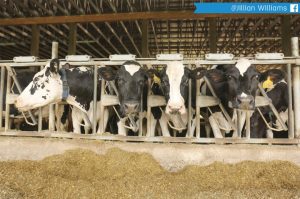- Staph. aureus: A common culprit in Canadian dairy herds, Staph. aureus can cause both clinical and subclinical mastitis. It is particularly challenging due to its ability to evade the cow’s immune system and its potential resistance to antibiotics, making it difficult to eliminate from herds.
- Strep. agalactiae: This is a highly contagious bacteria that spreads rapidly within a herd. Fortunately, control efforts have been highly effective over the last couple of decades, and infections have become rare in Canada.
- Mycoplasma bovis: This pathogen is an emerging concern due to its natural resistance to many antibiotics (due to lack of a cell wall). It can cause severe, chronic mastitis affecting multiple udder quarters and can also lead to respiratory disease and arthritis, particularly in calves.
Alberta study results: The current picture
Bulk tank milk samples from Alberta dairy herds were collected and analyzed three times during 2022 using qPCR (quantitative polymerase chain reaction), a technique that detects the DNA of the bacteria. The study revealed that Staph. aureus was detected in 59% of herds, making it the most widespread contagious mastitis pathogen in Alberta. Strep. agalactiae was detected in only 1.7% of herds, reflecting the success of longstanding control efforts in Canada. Meanwhile, Mycoplasma bovis was found in 1.5% of herds. While still relatively uncommon, Mycoplasma bovis remains a concern because it affects not just the udder but also the respiratory system and joints, and it also often causes disease in youngstock, making it harder to detect solely through bulk tank testing.
The study also found regional differences in the percentage of herds affected. Staph. aureus was more common in northern Alberta than in central and southern regions. Additionally, herds using automated milking systems were more frequently positive for Staph. aureus compared to those using conventional milking systems. This highlights the need for tailored management strategies in different farm setups.
Putting research to work: Practical implication for dairy producers
The study’s findings reinforce the importance of proactive mastitis control, including understanding the causative agents responsible for infections. Dairy producers, particularly those in Alberta, can take several steps to mitigate the spread of contagious mastitis pathogens. Producers using robotic milking systems should prioritize cleaning protocols, including frequent liner changes and effective teat disinfection. Because contagious mastitis spreads from cow to cow, proper milking hygiene is critical – this includes ensuring cows are adequately teat-dipped after milking and that milking equipment is functioning properly. Infected cows should be milked last to prevent pathogen transmission.
Regular bulk tank milk screening can help detect emerging infections before they become herd-wide issues. Chronic Staph. aureus infections are difficult to treat, so removing persistently infected cows can significantly reduce the pathogen load from the herd. Additionally, limiting the introduction of new animals without proper screening can prevent new infections from entering the herd.
Working toward a healthier dairy industry
Contagious mastitis remains a significant concern for Canadian dairy producers, but proactive management can help reduce its impact. Understanding the bacteria involved, implementing effective control measures and working closely with a herd veterinarian can improve herd health, milk quality and overall farm profitability.
This research was supported by the Sustainable Canadian Agriculture Partnership (S-CAP); Results Driven Agriculture Research (RDAR); Alberta Milk, Natural Sciences and Engineering Research Council (NSERC) Industrial Research Chair in Infectious Disease; Dairy Farmers of Canada; and other industry partners of Barkema’s research program.
You can now read the most important #news on #eDairyNews #Whatsapp channels!!!
🇺🇸 eDairy News INGLÊS: https://whatsapp.com/channel/0029VaKsjzGDTkJyIN6hcP1K


























